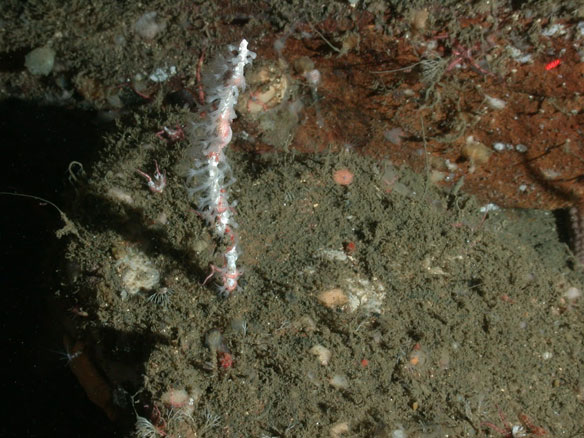
This is a new species of white coral, found in an area known as The Football. Most likely it is closely related to gorgonian corals. NOAA.
By NOAA;
A NOAA-led research team has discovered a new species of deep-sea coral and a nursery area for catsharks and skates in the underwater canyons located close to the Gulf of Farallones and Cordell Bank national marine sanctuaries off the Sonoma coast.
In the first intensive exploration of California’s offshore areas north of Bodega Head, a consortium of federal and state marine scientists used small submersibles and other innovative technologies to investigate, film and photograph marine life that has adapted to survive in offshore waters reaching 1,000 feet deep.
The exploration took place in September on NOAA’s R/V Fulmar and focused on two main sites: the head waters of Bodega Canyon and “the Football” – an area west of Salmon Creek and north of the canyon nicknamed for its oval shape. Prior to this expedition, scientists knew little about these areas except that they were thought to contain nutrient-rich and biologically diverse marine life.
After multiple dives, the research team made two significant discoveries — hundreds of skate egg cases on the seafloor, and in bundles on the rocks surrounding a catshark nursery area.
“This is a highly unusual nursery because rarely, if ever, are shark nurseries in the same area as skate nurseries,” said Peter Etnoyer, a deep-sea biologist at NOAA’s National Centers for Coastal Ocean Science.
One significant discovery was by made by a second team on the mission, led by California Academy of Sciences’ Gary Williams, who found corals approximately 600 feet deep that are a new species of deep-sea coral from the Leptogorgia genus.
“Deep-sea corals and sponges provide valuable refuge for fish and other marine life,” said Maria Brown, Farallones sanctuary superintendent. “Data on these life forms helps determine the extent and ecological importance of deep-sea communities and the threats they face. Effective management of these ecosystems requires science-based information on their condition.”
In addition to the discoveries, the research team also conducted video surveys of areas that previously were documented only through sonar imaging.
“The video surveys from this research mission verified the extent of rocky habitat estimated from sonar data collected several years ago, and the quality of rocky habitat in some areas exceeded expectations,” said Guy Cochrane, a U.S. Geological Survey geophysicist.
Submarine canyons, such as Bodega Canyon, extend from the continental shelf to the deep sea – making their exploration a difficult but worthwhile endeavor. The canyons are important because they act as a refuge for important species of fish and provide a habitat for sensitive species of deep water corals and sponges.
“Surveys of the seafloor in these waters reveal an abundance and diversity of life in new habitats,” said Danielle Lipski, Cordell Bank National Marine Sanctuary research coordinator and expedition leader. “This work helps inform our knowledge and understanding of the deep sea ecosystems north of Cordell Bank and Gulf of the Farallones national marine sanctuaries, areas that are extremely important to the ocean environment.”
The research expedition was made possible by partnerships and collaboration among government and academic partners including NOAA’s Office of National Marine Sanctuaries, NOAA National Center for Coastal Ocean Science’s, Gulf of the Farallones and Cordell Bank national marine sanctuaries, the U.S. Geological Survey and the California Academy of Sciences.
The U.S. Geological Survey serves the nation by providing reliable scientific information to describe and understand the Earth; minimize loss of life and property from natural disasters; manage water, biological, energy, and mineral resources; and enhance and protect our quality of life.
The California Academy of Sciences is a world-class scientific and cultural institution based in San Francisco. Its mission is to explore, explain and protect the natural world.








